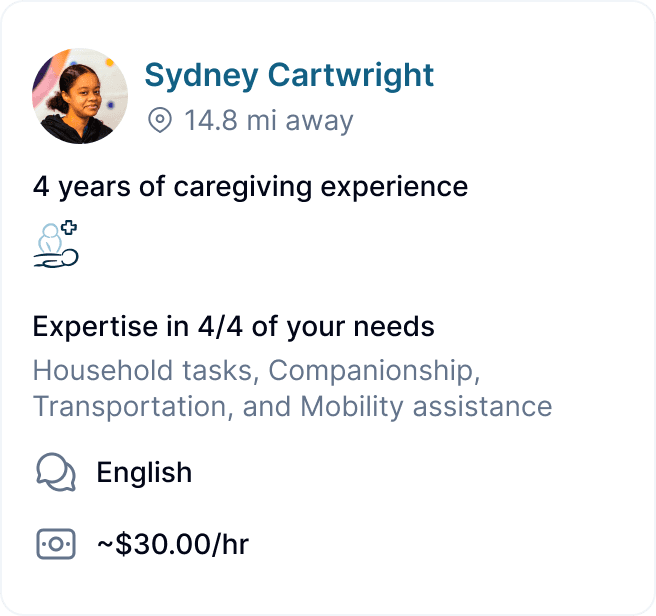Can a Family Member Be Paid to Be a Caretaker in California?
Apr 28, 2025
Apr 28, 2025



Caring for an aging or disabled loved one at home is a profound act of love-but it can also place a significant financial and emotional burden on families. In locations like the San Francisco Bay Area, where the cost of living is high and the need for quality in-home care is growing, many families wonder: Can a family member be paid to be a caretaker?
The answer is yes-under certain programs and circumstances, California does offer ways for family caregivers to receive compensation for their essential work.
Understanding Paid Family Caregiving in California
California recognizes the invaluable role that family caregivers play, and several state and federal programs allow for compensation. The most prominent of these is the In-Home Supportive Services (IHSS) program, but there are also options for veterans, those with long-term care insurance (LTCI), and through Paid Family Leave.
1. In-Home Supportive Services (IHSS)
The IHSS program is the main avenue for family members to be paid for caregiving in California, including the Bay Area. IHSS is funded by Medi-Cal (California’s Medicaid program) and is designed to help eligible older adults and people with disabilities remain safely in their homes rather than moving to institutional care. (See here for more about in-home care).
How IHSS Works:
The person needing care (the “recipient”) must be eligible for Medi-Cal and require assistance with activities of daily living, such as bathing, dressing, meal preparation, and mobility.
After applying, the county conducts an in-home assessment to determine the number of care hours needed.
The recipient can then hire, train, and supervise their own caregiver—which can be a family member, including adult children, siblings, or even, in many cases, a spouse.
The state pays the caregiver an hourly wage, which varies by county but typically ranges from about $13 to $18 per hour in the Bay Area (1).
Who Can Be Paid?
Most relatives, including adult children and, under certain circumstances, spouses, can be paid through IHSS.
There are some restrictions: for example, parents of minor children are generally not eligible to be paid for caregiving under IHSS.
Application Steps:
Apply for Medi-Cal if not already enrolled.
Contact your local county IHSS office to request an assessment.
Complete the application and participate in the in-home evaluation.
Once approved, select your caregiver (who must also complete certain enrollment steps).
2. Veterans’ Programs
If your loved one is a veteran, additional programs may be available:
Aid & Attendance and Housebound Benefits: These are enhancements to a veteran’s pension that can help pay for in-home care, including care provided by a family member.
Veteran Directed Care: This program offers eligible veterans a flexible budget to hire caregivers, including family members, for personal care and support.
3. Long-Term Care Insurance
Some long-term care insurance policies allow for payments to family caregivers, provided the policyholder is eligible and the policy permits care provided outside of licensed facilities. This is less common, but worth investigating if your loved one has a policy.
4. Paid Family Leave (PFL)
California’s Paid Family Leave program allows employees to take up to eight weeks off work to care for a seriously ill family member while receiving 60-70% of their salary. While this isn’t direct payment for caregiving, it does provide financial support during a caregiving leave (2).
Eligibility Requirements and Considerations
Each program has its own eligibility requirements. Here are key factors to consider:
Financial Eligibility: Most programs, especially IHSS, require the care recipient to meet Medi-Cal’s income and asset limits.
Level of Need: The recipient must require assistance with daily living activities.
Caregiver Restrictions: Some programs restrict payment to certain family members. For example, IHSS generally allows payment to most relatives, but there are exceptions for parents of minors.
Documentation: Accurate records, timesheets, and sometimes background checks or training may be required.
How Much Can a Family Caregiver Earn?
The pay rate for family caregivers under IHSS varies by county and is periodically adjusted. In the Bay Area, rates typically range from $13 to $18 per hour, depending on the county and the negotiated wage for IHSS providers. The number of paid hours is determined by the recipient’s assessed needs.
For veterans’ programs, the amount may be tied to pension enhancements or a flexible budget, and for Paid Family Leave, it’s a percentage of the caregiver’s regular wages.
Benefits and Challenges of Being a Paid Family Caregiver
Benefits:
Allows loved ones to remain at home in familiar surroundings. (See here for more on the importance of aging in place).
Provides financial support to caregivers who might otherwise have to cut back on work or experience hardship.
Empowers families to choose and supervise their own caregivers.
Challenges:
Navigating eligibility and application processes can be complex.
Payment rates may not fully replace lost income from full-time employment.
Caregiving can be emotionally and physically demanding, and caregivers may need additional support and respite.
Next Steps
If you’re interested in being paid to care for a family member in California, here’s a quick action plan:
Assess Care Needs: Determine the level of care your loved one requires.
Check Eligibility: Review Medi-Cal and IHSS requirements, or veterans’ benefits if applicable.
Apply for Programs: Start with IHSS if your loved one is Medi-Cal eligible, or explore veterans’ programs and Paid Family Leave.
Get Support: Reach out to experts-Clara can help you navigate the process and provide additional care solutions if needed.
Conclusion
Yes, a family member can be paid to be a caretaker in California, primarily through the IHSS program and, for veterans, through specific VA benefits. While the process requires careful navigation of eligibility and paperwork, the financial and emotional support provided can make a significant difference for families.
At Clara Home Care, we help families in the Bay Area find more affordable home care by making it easy to directly employ a caregiver from our network of over 1,000 trusted professionals. Reach out to us today to learn how we can support your family's needs.
References
1. https://www.downersgrovehc.com/blog/what-states-pay-family-caregivers
2. https://www.payingforseniorcare.com/paid-caregiver/california
Caring for an aging or disabled loved one at home is a profound act of love-but it can also place a significant financial and emotional burden on families. In locations like the San Francisco Bay Area, where the cost of living is high and the need for quality in-home care is growing, many families wonder: Can a family member be paid to be a caretaker?
The answer is yes-under certain programs and circumstances, California does offer ways for family caregivers to receive compensation for their essential work.
Understanding Paid Family Caregiving in California
California recognizes the invaluable role that family caregivers play, and several state and federal programs allow for compensation. The most prominent of these is the In-Home Supportive Services (IHSS) program, but there are also options for veterans, those with long-term care insurance (LTCI), and through Paid Family Leave.
1. In-Home Supportive Services (IHSS)
The IHSS program is the main avenue for family members to be paid for caregiving in California, including the Bay Area. IHSS is funded by Medi-Cal (California’s Medicaid program) and is designed to help eligible older adults and people with disabilities remain safely in their homes rather than moving to institutional care. (See here for more about in-home care).
How IHSS Works:
The person needing care (the “recipient”) must be eligible for Medi-Cal and require assistance with activities of daily living, such as bathing, dressing, meal preparation, and mobility.
After applying, the county conducts an in-home assessment to determine the number of care hours needed.
The recipient can then hire, train, and supervise their own caregiver—which can be a family member, including adult children, siblings, or even, in many cases, a spouse.
The state pays the caregiver an hourly wage, which varies by county but typically ranges from about $13 to $18 per hour in the Bay Area (1).
Who Can Be Paid?
Most relatives, including adult children and, under certain circumstances, spouses, can be paid through IHSS.
There are some restrictions: for example, parents of minor children are generally not eligible to be paid for caregiving under IHSS.
Application Steps:
Apply for Medi-Cal if not already enrolled.
Contact your local county IHSS office to request an assessment.
Complete the application and participate in the in-home evaluation.
Once approved, select your caregiver (who must also complete certain enrollment steps).
2. Veterans’ Programs
If your loved one is a veteran, additional programs may be available:
Aid & Attendance and Housebound Benefits: These are enhancements to a veteran’s pension that can help pay for in-home care, including care provided by a family member.
Veteran Directed Care: This program offers eligible veterans a flexible budget to hire caregivers, including family members, for personal care and support.
3. Long-Term Care Insurance
Some long-term care insurance policies allow for payments to family caregivers, provided the policyholder is eligible and the policy permits care provided outside of licensed facilities. This is less common, but worth investigating if your loved one has a policy.
4. Paid Family Leave (PFL)
California’s Paid Family Leave program allows employees to take up to eight weeks off work to care for a seriously ill family member while receiving 60-70% of their salary. While this isn’t direct payment for caregiving, it does provide financial support during a caregiving leave (2).
Eligibility Requirements and Considerations
Each program has its own eligibility requirements. Here are key factors to consider:
Financial Eligibility: Most programs, especially IHSS, require the care recipient to meet Medi-Cal’s income and asset limits.
Level of Need: The recipient must require assistance with daily living activities.
Caregiver Restrictions: Some programs restrict payment to certain family members. For example, IHSS generally allows payment to most relatives, but there are exceptions for parents of minors.
Documentation: Accurate records, timesheets, and sometimes background checks or training may be required.
How Much Can a Family Caregiver Earn?
The pay rate for family caregivers under IHSS varies by county and is periodically adjusted. In the Bay Area, rates typically range from $13 to $18 per hour, depending on the county and the negotiated wage for IHSS providers. The number of paid hours is determined by the recipient’s assessed needs.
For veterans’ programs, the amount may be tied to pension enhancements or a flexible budget, and for Paid Family Leave, it’s a percentage of the caregiver’s regular wages.
Benefits and Challenges of Being a Paid Family Caregiver
Benefits:
Allows loved ones to remain at home in familiar surroundings. (See here for more on the importance of aging in place).
Provides financial support to caregivers who might otherwise have to cut back on work or experience hardship.
Empowers families to choose and supervise their own caregivers.
Challenges:
Navigating eligibility and application processes can be complex.
Payment rates may not fully replace lost income from full-time employment.
Caregiving can be emotionally and physically demanding, and caregivers may need additional support and respite.
Next Steps
If you’re interested in being paid to care for a family member in California, here’s a quick action plan:
Assess Care Needs: Determine the level of care your loved one requires.
Check Eligibility: Review Medi-Cal and IHSS requirements, or veterans’ benefits if applicable.
Apply for Programs: Start with IHSS if your loved one is Medi-Cal eligible, or explore veterans’ programs and Paid Family Leave.
Get Support: Reach out to experts-Clara can help you navigate the process and provide additional care solutions if needed.
Conclusion
Yes, a family member can be paid to be a caretaker in California, primarily through the IHSS program and, for veterans, through specific VA benefits. While the process requires careful navigation of eligibility and paperwork, the financial and emotional support provided can make a significant difference for families.
At Clara Home Care, we help families in the Bay Area find more affordable home care by making it easy to directly employ a caregiver from our network of over 1,000 trusted professionals. Reach out to us today to learn how we can support your family's needs.
References
1. https://www.downersgrovehc.com/blog/what-states-pay-family-caregivers
2. https://www.payingforseniorcare.com/paid-caregiver/california
Caring for an aging or disabled loved one at home is a profound act of love-but it can also place a significant financial and emotional burden on families. In locations like the San Francisco Bay Area, where the cost of living is high and the need for quality in-home care is growing, many families wonder: Can a family member be paid to be a caretaker?
The answer is yes-under certain programs and circumstances, California does offer ways for family caregivers to receive compensation for their essential work.
Understanding Paid Family Caregiving in California
California recognizes the invaluable role that family caregivers play, and several state and federal programs allow for compensation. The most prominent of these is the In-Home Supportive Services (IHSS) program, but there are also options for veterans, those with long-term care insurance (LTCI), and through Paid Family Leave.
1. In-Home Supportive Services (IHSS)
The IHSS program is the main avenue for family members to be paid for caregiving in California, including the Bay Area. IHSS is funded by Medi-Cal (California’s Medicaid program) and is designed to help eligible older adults and people with disabilities remain safely in their homes rather than moving to institutional care. (See here for more about in-home care).
How IHSS Works:
The person needing care (the “recipient”) must be eligible for Medi-Cal and require assistance with activities of daily living, such as bathing, dressing, meal preparation, and mobility.
After applying, the county conducts an in-home assessment to determine the number of care hours needed.
The recipient can then hire, train, and supervise their own caregiver—which can be a family member, including adult children, siblings, or even, in many cases, a spouse.
The state pays the caregiver an hourly wage, which varies by county but typically ranges from about $13 to $18 per hour in the Bay Area (1).
Who Can Be Paid?
Most relatives, including adult children and, under certain circumstances, spouses, can be paid through IHSS.
There are some restrictions: for example, parents of minor children are generally not eligible to be paid for caregiving under IHSS.
Application Steps:
Apply for Medi-Cal if not already enrolled.
Contact your local county IHSS office to request an assessment.
Complete the application and participate in the in-home evaluation.
Once approved, select your caregiver (who must also complete certain enrollment steps).
2. Veterans’ Programs
If your loved one is a veteran, additional programs may be available:
Aid & Attendance and Housebound Benefits: These are enhancements to a veteran’s pension that can help pay for in-home care, including care provided by a family member.
Veteran Directed Care: This program offers eligible veterans a flexible budget to hire caregivers, including family members, for personal care and support.
3. Long-Term Care Insurance
Some long-term care insurance policies allow for payments to family caregivers, provided the policyholder is eligible and the policy permits care provided outside of licensed facilities. This is less common, but worth investigating if your loved one has a policy.
4. Paid Family Leave (PFL)
California’s Paid Family Leave program allows employees to take up to eight weeks off work to care for a seriously ill family member while receiving 60-70% of their salary. While this isn’t direct payment for caregiving, it does provide financial support during a caregiving leave (2).
Eligibility Requirements and Considerations
Each program has its own eligibility requirements. Here are key factors to consider:
Financial Eligibility: Most programs, especially IHSS, require the care recipient to meet Medi-Cal’s income and asset limits.
Level of Need: The recipient must require assistance with daily living activities.
Caregiver Restrictions: Some programs restrict payment to certain family members. For example, IHSS generally allows payment to most relatives, but there are exceptions for parents of minors.
Documentation: Accurate records, timesheets, and sometimes background checks or training may be required.
How Much Can a Family Caregiver Earn?
The pay rate for family caregivers under IHSS varies by county and is periodically adjusted. In the Bay Area, rates typically range from $13 to $18 per hour, depending on the county and the negotiated wage for IHSS providers. The number of paid hours is determined by the recipient’s assessed needs.
For veterans’ programs, the amount may be tied to pension enhancements or a flexible budget, and for Paid Family Leave, it’s a percentage of the caregiver’s regular wages.
Benefits and Challenges of Being a Paid Family Caregiver
Benefits:
Allows loved ones to remain at home in familiar surroundings. (See here for more on the importance of aging in place).
Provides financial support to caregivers who might otherwise have to cut back on work or experience hardship.
Empowers families to choose and supervise their own caregivers.
Challenges:
Navigating eligibility and application processes can be complex.
Payment rates may not fully replace lost income from full-time employment.
Caregiving can be emotionally and physically demanding, and caregivers may need additional support and respite.
Next Steps
If you’re interested in being paid to care for a family member in California, here’s a quick action plan:
Assess Care Needs: Determine the level of care your loved one requires.
Check Eligibility: Review Medi-Cal and IHSS requirements, or veterans’ benefits if applicable.
Apply for Programs: Start with IHSS if your loved one is Medi-Cal eligible, or explore veterans’ programs and Paid Family Leave.
Get Support: Reach out to experts-Clara can help you navigate the process and provide additional care solutions if needed.
Conclusion
Yes, a family member can be paid to be a caretaker in California, primarily through the IHSS program and, for veterans, through specific VA benefits. While the process requires careful navigation of eligibility and paperwork, the financial and emotional support provided can make a significant difference for families.
At Clara Home Care, we help families in the Bay Area find more affordable home care by making it easy to directly employ a caregiver from our network of over 1,000 trusted professionals. Reach out to us today to learn how we can support your family's needs.
References
1. https://www.downersgrovehc.com/blog/what-states-pay-family-caregivers
2. https://www.payingforseniorcare.com/paid-caregiver/california
More about caring for family
More about caring for family


Aging Parents and Elder Care: A Starter Pack for Care Novices



Lowrie Hilladakis


When Is It Time for Assisted Living—or Is In-Home Care the Better Choice?



Lowrie Hilladakis


Making Tough Choices Easier: The Power of Advance Care Planning



Lowrie Hilladakis


Understanding the Emotional Impact of Caring for Aging Parents



Vanessa Bustos


Balancing Work and Caregiving: Strategies for Busy Families



Vanessa Bustos


Coordinating Long-Distance Care: A Guide to Supporting Loved Ones from Afar



Jon Levinson


Setting Boundaries Without Guilt: A Family Caregiver's Guide



Vanessa Bustos


How to Foster Cooperation Among Family Members in Senior Care



Jon Levinson


Respite Care Explained: A Short Guide for Family Caregivers



Lowrie Hilladakis


Showing Yourself Love: How Hiring a Caregiver Can Be an Act of Self-Care



Jon Levinson
GEt started for free
Better care starts with Clara.
Find, hire, and pay top-notch caregivers without the headache for a price that fits your budget.



GEt started for free
Better care starts with Clara.
Find, hire, and pay top-notch caregivers without the headache for a price that fits your budget.



GEt started for free
Better care starts with Clara.
Find, hire, and pay top-notch caregivers without the headache for a price that fits your budget.

